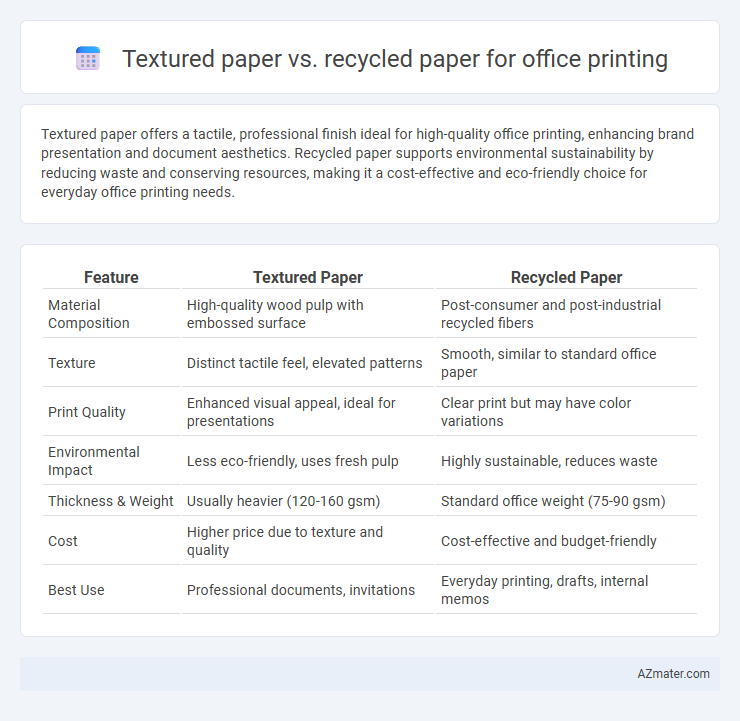Textured paper offers a tactile, professional finish ideal for high-quality office printing, enhancing brand presentation and document aesthetics. Recycled paper supports environmental sustainability by reducing waste and conserving resources, making it a cost-effective and eco-friendly choice for everyday office printing needs.
Table of Comparison
| Feature | Textured Paper | Recycled Paper |
|---|---|---|
| Material Composition | High-quality wood pulp with embossed surface | Post-consumer and post-industrial recycled fibers |
| Texture | Distinct tactile feel, elevated patterns | Smooth, similar to standard office paper |
| Print Quality | Enhanced visual appeal, ideal for presentations | Clear print but may have color variations |
| Environmental Impact | Less eco-friendly, uses fresh pulp | Highly sustainable, reduces waste |
| Thickness & Weight | Usually heavier (120-160 gsm) | Standard office weight (75-90 gsm) |
| Cost | Higher price due to texture and quality | Cost-effective and budget-friendly |
| Best Use | Professional documents, invitations | Everyday printing, drafts, internal memos |
Introduction to Office Printing Paper Choices
Textured paper offers a tactile, professional finish ideal for presentations and high-quality documents, enhancing visual appeal and readability in office printing. Recycled paper supports environmental sustainability by reducing waste and conserving resources, making it a cost-effective choice for everyday printing needs. Selecting between textured and recycled paper depends on balancing presentation quality with eco-friendly practices in office workflows.
What is Textured Paper?
Textured paper features a tactile surface with patterns such as linen, felt, or woven designs that enhance the visual and physical appeal of printed materials. This type of paper is commonly chosen for high-quality presentations, invitations, and professional documents where a distinctive feel is desired. Its textured surface can affect ink absorption and print clarity, making it less ideal for everyday office printing compared to smoother recycled paper designed for efficiency and sustainability.
What is Recycled Paper?
Recycled paper is produced from waste paper materials that are reprocessed to create new sheets, reducing environmental impact by conserving natural resources and decreasing landfill waste. It is commonly used in office printing due to its eco-friendly properties and often contains post-consumer content verified by certifications like FSC or EPA. Unlike textured paper, recycled paper typically has a smoother finish suitable for standard printers and copiers, balancing sustainability with functionality in everyday office tasks.
Appearance and Aesthetics Comparison
Textured paper offers a distinct tactile feel and visual depth that enhances the professionalism and sophistication of printed office materials, making logos and graphics appear more vibrant and refined. Recycled paper, while eco-friendly, often has a more muted, matte finish with visible fibers that can slightly diminish the sharpness and brightness of printed images. Choosing textured paper improves aesthetic appeal and sensory engagement, whereas recycled paper prioritizes sustainability with a rustic, natural look.
Print Quality and Performance Differences
Textured paper offers enhanced print quality with a unique tactile feel that highlights ink sharpness and depth, making it ideal for professional presentations or creative projects. Recycled paper typically provides reliable print performance with good opacity and brightness but may show slight variations in texture and color uniformity due to fiber composition. Both types perform well in standard office printers, but textured paper demands careful handling to prevent smudging, while recycled paper supports sustainability without significant compromise in clarity or durability.
Environmental Impact and Sustainability
Textured paper typically involves more complex manufacturing processes that can increase water and energy consumption compared to recycled paper, which is made from post-consumer waste and reduces landfill reliance. Using recycled paper significantly lowers carbon emissions and conserves natural resources by minimizing the need for virgin pulp. Choosing recycled paper for office printing supports sustainability goals by promoting waste reduction and circular economy practices.
Cost Analysis: Textured vs Recycled Paper
Textured paper generally incurs higher costs than recycled paper due to specialized manufacturing processes and premium quality materials. Recycled paper offers a more economical option for office printing, leveraging post-consumer waste and energy-efficient production techniques that reduce expenses. Cost analysis reveals that choosing recycled paper can lower overall printing expenses while supporting sustainability initiatives without significantly compromising print quality.
Compatibility with Office Printers
Textured paper often poses compatibility challenges with office printers due to its uneven surface, which can cause smudging, paper jams, or uneven ink absorption in inkjet and laser printers. Recycled paper, designed to meet standard office printing specifications, generally performs reliably across various printer types, ensuring smooth feeding and consistent print quality. Choosing recycled paper typically enhances printer efficiency and reduces maintenance issues compared to textured paper in high-volume office environments.
Best Use Cases for Each Paper Type
Textured paper enhances professional presentations and formal documents by providing a tactile, high-quality finish ideal for business proposals and invitations. Recycled paper suits everyday office printing needs, offering an eco-friendly option for internal memos, drafts, and bulk print jobs. Choosing textured paper emphasizes aesthetics and impression, while recycled paper prioritizes sustainability and cost-effectiveness.
Choosing the Right Paper for Your Office Needs
Textured paper offers a professional finish ideal for marketing materials and presentations, enhancing visual appeal and tactile experience. Recycled paper supports sustainability goals by reducing environmental impact without compromising print quality, making it suitable for everyday office printing. Selecting the right paper depends on balancing budget, environmental responsibility, and the desired impression of your documents.

Infographic: Textured paper vs Recycled paper for Office printing
 azmater.com
azmater.com